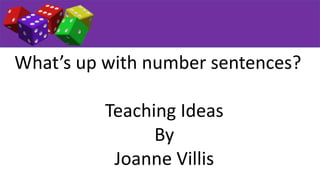Number sentences j villis
- 1. What’s up with number sentences? Teaching Ideas By Joanne Villis
- 2. As a teacher, have you even been frustrated with students not knowing the relationship between number operations?
- 3. These ideas might help you?
- 4. Australian Curriculum Year 3 Recognise and explain the connection between addition and subtraction (ACMNA054) Represent and solve problems involving multiplication using efficient mental and written strategies and appropriate digital technologies (ACMNA057) Year 4 Use equivalent number sentences involving addition and subtraction to find unknown quantities (ACMNA083)
- 5. Whiteboard Wonders Use your whiteboard as a number wonder board. To do this, you need to ‘hand over’ your whiteboard to your students. Each week, write a wonder question on the board and allow students to share their answers. Examples of wonder questions might include: - The answer is 13. I wonder what the question might be? - The answer is the product of 6 and 3. I wonder what the question might be? - Ms Villis had $23 but now she only has $8. I wonder what happened to her money?
- 6. Whiteboard Wonders - The sum of 3 consecutive numbers is 312. I wonder what the numbers might be? - The answer is numbers. I wonder what the question might be? - I subtracted an odd number from an even number and got the answer of 41. What might the odd and even numbers be? - I had some lollies and I gave away some. Now I have 15 left. How many might I have started with?
- 7. What might the number sentence be? 1. On a smart board or whiteboard write the numbers 6 and 9. Ask students what is the total of 6 and 9? How did they work it out? What was the number sentence they used? (ie 6+9= 15). How else might we write the number sentence? (ie 9+5=15 or 15= 6+9 or 15=9+6). Many student may comment that 15=6+9 looks weird. This is because many may not be used to seeing this. Emphasise that a number sentence is like a set of scales, what ever is on one side of the equals symbol is equal to, balances or is equivalent to the other side.
- 8. What might the number sentence be? 2. Ask students, what is the total of 9 an 23? How many ways can they think of in order to solve the problem? 3. Invite students to consider a total of 15. What symbols and numbers can they use to write a number sentence with the total being 15. For example, 10+5= 15, 4+11=15, 20-5=15, 3x5=15, 30/2=15. 4. Write the numbers 8, 15 and 7 on the board. Invite the class to brainstorm how they might use each of the numbers to create a number sentence. For example: 8+7=15 or 7+8=15 or 15=8+7 or 15-8=7 etc.
- 9. What might the number sentence be? 5. Write the numbers 1, 2, 3 and 6 on a board. Brainstorm possible number sentences as a class. For example, 1+2+3=6 or 6= 1+2+3 or 3x2= 6x1 or 2x3=1x6 or 6/1= 3x2 6. Then ask students to individually explore the possible number sentences for 2, 6, 12 and 4. Encourage to consider addition, subtraction, multiplication and division. 7. What about the numbers 74, 87 and 161? What could the number sentences be?
- 10. What might the number pattern be? 8. Give students open ended worded problems like the one below: Zac created an addition number pattern which contained the number 20. What could the pattern be? Then substitute the word ‘addition’ with subtraction, multiplication and division. You can also make the number larger. Remember to ask students to explain their pattern (ie write a rule). Teaching idea came from Y3 Work Samples Online: http://www.australiancurriculum.edu.au/mathematics/Curriculum/F- 10?layout=1#level3
- 11. What might the number sentences be? 9. The answer to a division question is 5. What might the question be? 10. The answer to a division question is 3. What might the question be? 11. The answer to a multiplication question is 100. What might the question be? 12. Use the digits 5, 4, 2, 5 and 3 with the + and – symbol to create a total of 72. How might you do this? (ie 54+23-5=72). This is an extension activity.
- 12. iPad Apps Red Dragon Fly (free) Maths Doodles ($2.99 ) Crackers and Go ($2.99 ) 5Dice (free)
- 13. Worded problem online generator My favourite online worded problem generator is a free website called Maths.aid.com . You can select the operation of the worded problems which you would like, their difficulty (1 digit or 2 digits) and if you would like any irrelevant information included.
- 14. Credits Some of the questions for this learning resource were modified from the Australian Curriculum Student Samples Resource pages. They were collated into a slideshare by Joanne Villis. Here is a link to my blog: http://intertecheducation.edublogs.org/ Here is a link to my Pinterest page: http://www.pinterest.com/joannevillis/ This resource was shared on http://www.australiancurriculumlessons.com.au/ . If you like this resource please like on Facebook. ENJOY!

